In previous articles, we’ve covered the benefits of selling on Amazon and how to get started, as well as the difference between Seller and Vendor Central. But since Amazon just keeps getting bigger, it’s time we talk about Amazon SEO (Search Engine Optimization).
It goes without saying that Amazon is huge. Having obtained over 400,000 new sellers within the first half of 2018 alone, it is one of the most crowded and competitive marketplaces in the industry. So how can manufacturers, brands, and retailers cope with such a high level of competition? Well, simply put, Amazon sellers need to focus on product visibility and product buyability.
Though both are key to increased sales on Amazon, these two objectives are achieved in different ways and come into play during separate stages of the buying funnel. That said, product visibility is more about keyword search, whereas product buyability deals with Amazon’s infamous Buy Box. However, the two together make up Amazon SEO.
In this article, we’ll provide an overview of the two sides of Amazon SEO which is made up of product visibility and product buyability We'll then dive into the ranking factors of each and how you can leverage your product feed to drive both objectives.
Ready for a hike through the Amazon? Put on your boots and let’s go!
The two sides to Amazon SEO
Amazon SEO is made of up product visibility and product buyability. Before we get into the in-depth explanations of each, take a look at this infographic that simplifies the two main ingredients of Amazon SEO.
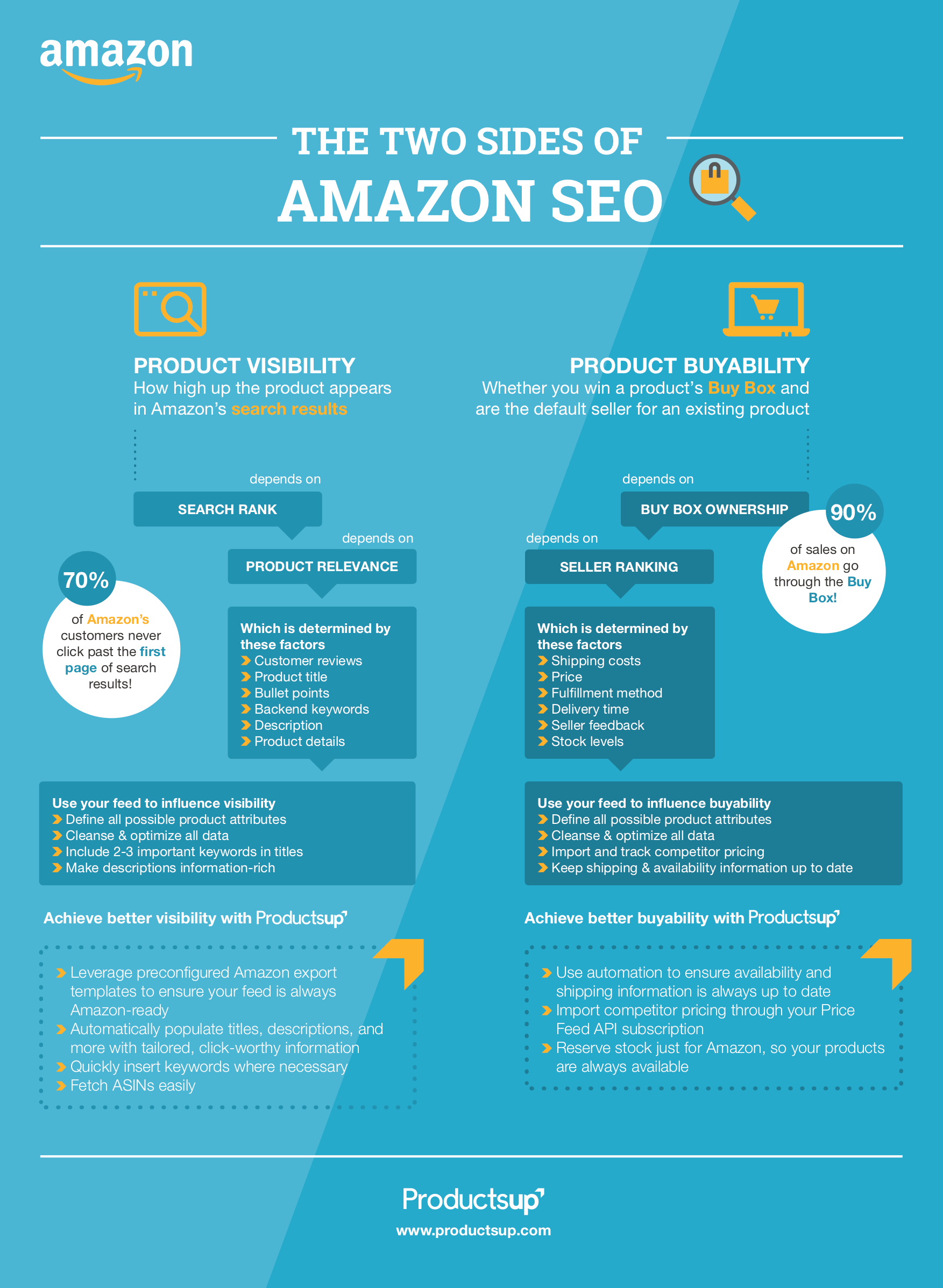
Download your free copy of this infographic here.
Now, let's take a closer look at both sides.
Product visibility on Amazon
At the end of the day, Amazon is a product search and buying engine. Therefore, it aims to accurately match search queries to the most relevant products - in the hopes of facilitating a sale. This is why product visibility on Amazon is highly dependant on your search ranking and product relevance.
Why ranking matters
Essentially, it matters because it's how your buyers are going to find you. Moreover, it’s been said that a majority of Amazon buyers usually purchase from the first page of search results - making it critical for you to be there. If your product is not where people are looking, they aren’t going to buy it.
What your search ranking is based on
In order to match the most relevant products with a given search, Amazon developed its A9 algorithm. While the exact structure of it remains a bit of a mystery, it’s clear that there are many factors involved.
Customer Reviews
Amazon takes buyer satisfaction very seriously. This is why it will always rank products with more positive reviews higher than those with fewer. If your products either don’t have reviews or have bad reviews, your chances of ranking are, unfortunately, quite poor.

The marketplace is also known to use machine learning, instead of taking an average in their star rating calculation. They consider other factors like the age of the review and whether or not the reviews are from verified purchasers. This means you’ll need to get genuine product ratings regularly.
Note: Customer reviews are specifically product based (appearing on the product details page) and therefore different than seller feedback, which is specific to an individual seller (appearing on a sellers page).
Title
One of the most valuable fields in the product listing is the title. Not only is it the first information that a customer will see about your product, but it also plays a huge role in how relevant it is to a search. While you should avoid keyword stuffing, it’s best practice to include 2-3 important terms, along with key product information within the category specific character field limit.
When coming up with a good product title for search, remember to think of your product, not as you would within your company, but as your consumer would when trying to find it. Moreover, we recommend placing the most relevant keywords early on within the title - as this has been known to trigger more relevance from Amazon’s search algorithm, A9.
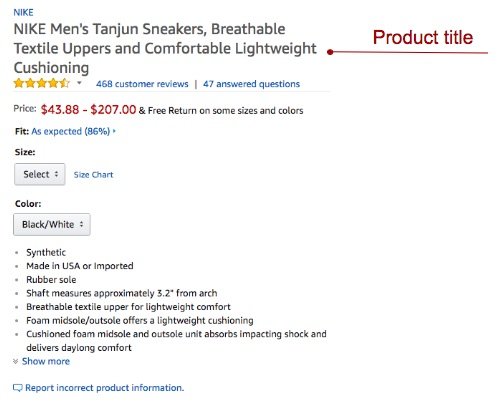
Amazon’s recommendations vary based on category, but as an example, here is what they suggest for Laptops:

Amazon’s style guidelines for product titles also recommend capitalizing the first letter of each word and writing all numbers as numerals (i.e. 3 instead of three). Also, make sure to avoid any information specific to you as a seller, since other sellers can join the product with their own offer as well.
Bullet Points
The next most important piece of high relevance & better conversion is easy-to-read, information-rich bullet points. The information contained in this section should focus on key product features and benefits. Keywords are also important in these points and will help Amazon’ algorithm match your product with a users search.
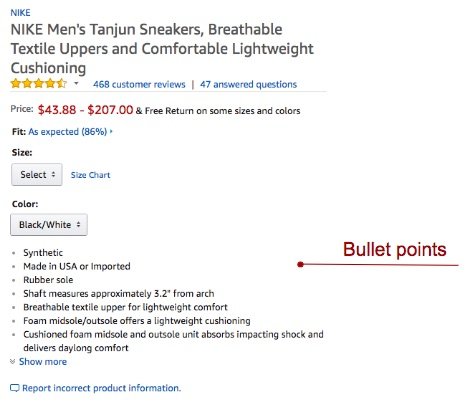
While each listing will include a minimum of 5 bullet points, the required information, and their order is based on product category, so be sure to take a look at Amazon’s best practices.
Here’s what Amazon recommends as a starting point for creating bullets:
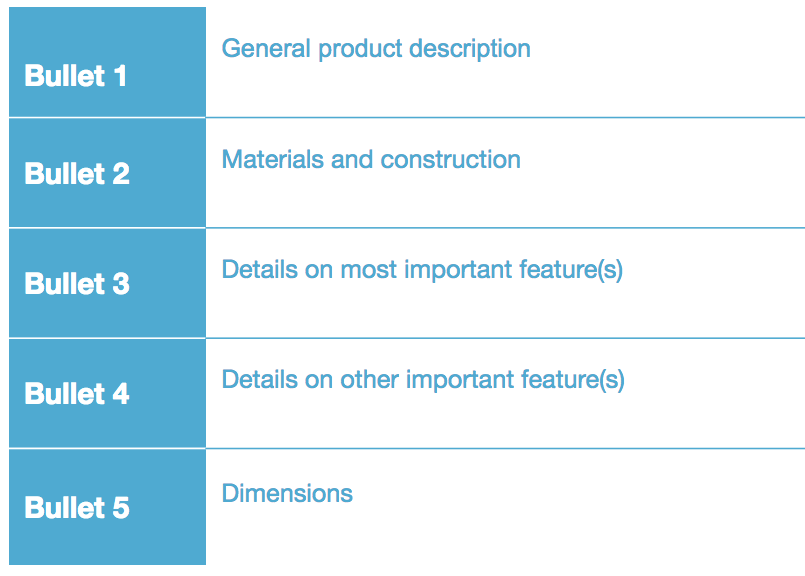
Backend Keywords
To avoid keyword stuffing in product titles, bullet points, and descriptions, Amazon has provided “general keywords” section to do just that! The backend search terms you define in Seller Central will never be seen by shoppers, but will be indexed by Amazon’s search algorithm to establish your product relevance. This is basically your opportunity to provide any keywords that didn’t fit well into any other field.
Here, there is no need to duplicate any words, as you should simply provide as many unique keywords as possible.
Here are a few best practice recommendations from Amazon:
- Don’t include brand names, ASINs
- No subjective claims (i.e. best, cheapest)
- No temporary statements (i.e. new, now)
- No punctuation or stop words (i.e. a, an) are necessary
- Include spelling variations, but not misspellings
Description
The product description should give the same or similar information as provided by the product manufacturer. Since this description is located about halfway down the product details page, it doesn’t play as critical a role as the bullet points but is still very important. In fact, it's recommended that the description is used to expand further on the details mentioned within the bullet points.
Here is an example of a product description that expands on the details listed in the bullet points:
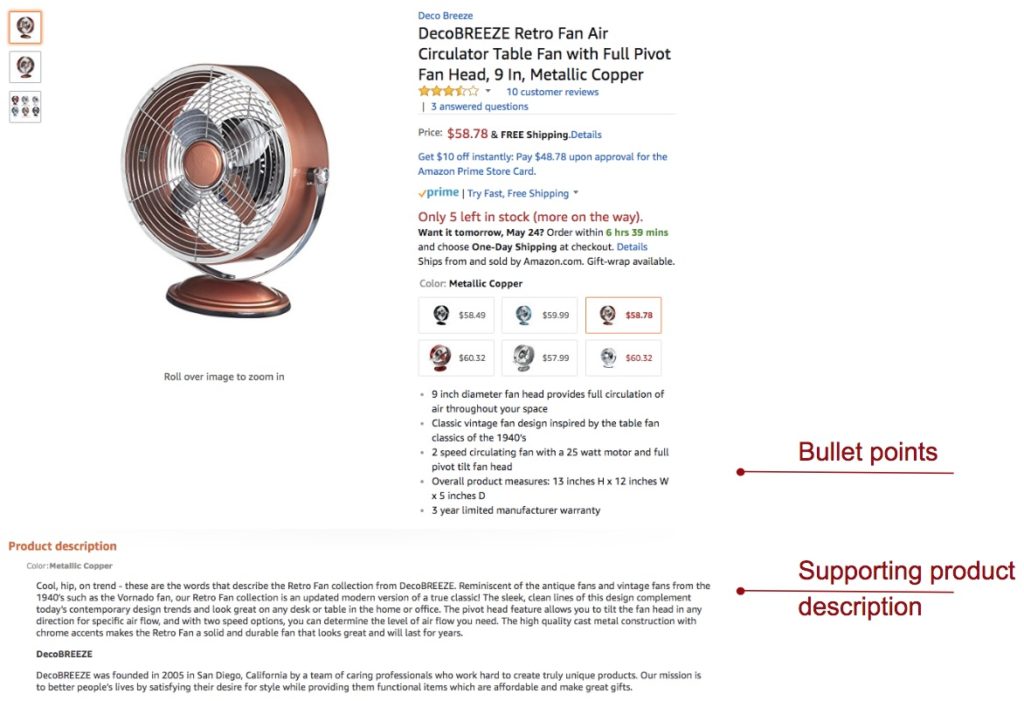
Product Details
This section of the product details page includes information like ASIN, shipping info, and product dimensions. On Amazon.com, this section appears directly underneath the product description, on Amazon.de, it’s placed above it. While not directly relating to your search ranking, it is always good practice to provide Amazon with as many product details as possible - as it can help show relevance.
Here is an example of the Product information section for the fan shown above:
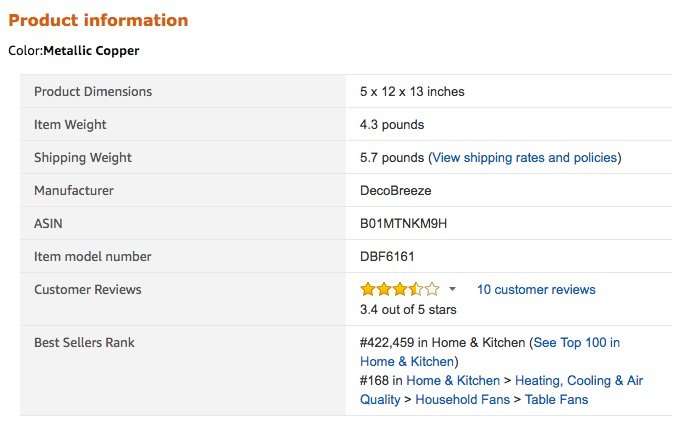
So with all these things to keep in mind, is there any way to make it a bit easier to optimize your product listing for Amazon search? Yes! The right feed management software will allow you to easily make changes to your feed that can result in higher product visibility on Amazon.
How to leverage your product feed to rank in Amazon search
The best and easiest way to create a product details page or product listing on Amazon is by using a product feed. Not only will it save you from having to manually add product information and waste time with small edits, but it also makes it easier to optimize your listing for Amazon search. Here are a few things you can do to leverage your product feed for Amazon search:
-
Define all attributes
The more information, the better. It is not only best practice to fill in as many information fields as you can, but it can also increase your chances of being relevant for more searches.
With Productsup, for example, it’s simple to populate fields with information that is already existing in other areas of your feed. Through drag-and-drop logic, you can create a more enriched feed which can result in increased relevance and conversion.
-
Optimize product data
Each section of the product details page comes with its own best practices. Good feed management software can make it easy to implement these to ensure a high-quality listing. For example, in order to follow Amazon's recommendation of having all words capitalized in your title, Productsup provides an intuitive rule box that can be applied with simple drag-and-drop. In this sense, product feed management software can help ensure your product content is as rich and optimized as possible, which will inevitably help you rank in Amazon search.
-
Use additional information to enhance feed
With the right product feed software, you can import additional feeds containing important information, like lists of keywords. For example, with Productsup you could import your lists of keywords, and prepend the most important one to the beginning of your titles - all with one simple edit.
So now that we’ve looked at product visibility on Amazon, let’s move onto product buyability - what it means, why it matters, and how to leverage your product feed to get it.
Product buyability on Amazon
First of all, we should make one thing clear:Amazon only allows one, single product details page per unique product. This means that if the fan you are selling is already on Amazon, you cannot create a second page for the same item. Instead, you would add your offer to the already existing listing. In this case, you do not have control over the information on the product details page - like title, bullet points, description etc. - and should switch your focus from visibility to buyability.
Since there is no limit to how many sellers can offer the same product, you are essentially competing with sellers of the same product on the listing itself. This is why buyability on Amazon is all about winning your share of the infamous Buy Box.
What is the Buy Box and it matters
The Buy Box is located on the top, right-hand side of the product details page. This is where buyers can easily add items to their cart. Essentially, this is the “real estate” that all sellers of the same product are competing for.
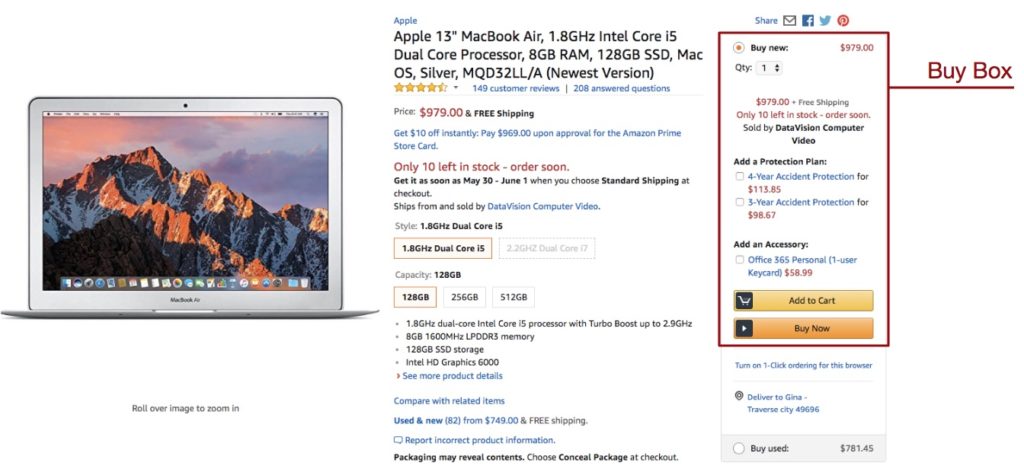
But why is it so important? Well, nearly 90% of sales on Amazon go through the Buy Box. Of course, it is still possible for shoppers to click on to view “all sellers,” but few do. On Amazon, winning the Buy Box is essentially winning the sales for that product.
We could talk a lot about the Buy Box and how it works, but for the sake of keeping this already-lengthy article short, let’s just get into what factors impact who wins the Buy Box.
What factors impact the Buy Box selection
Unlike product visibility where you’re aiming to get the listing seen, product buyability focuses on the seller itself. Here is what Amazon will look at when deciding if you are a seller worthy of the Buy Box.
Note: Not everyone is eligible to win the Buy Box. Check to see if you qualify here.
Shipping costs
Amazon is a huge fan of no shipping costs. That said, you are far more likely to win the Buy Box if you offer free shipping. Moreover, you’ll likely fall behind competition if they have lower or no shipping costs, and you don’t. When it comes to shipping, the cheaper the better.
Price
What was said for shipping, can also be said about price: the cheaper the better.
Fulfillment
Amazon will also look at your chosen fulfillment option. The preferred methods are either FBA (Fulfillment by Amazon) or SFP (Seller Fulfilled Prime). Although you can choose to ship the item yourself, it will not help you in your fight to win the Buy Box and could put you underneath competition. Here is a look at the Amazon Fulfilment options:
- __Fulfillment by Amazon ____(preferred)____- Amazon ships your products on your behalf.
- __Seller Fulfilled Prime ____(preferred)____- You ship products according to the standards of Amazon Prime.__
- __Self-shipment____-__ You ship at your own pace.
Delivery time
In order to even be considered for the Buy Box, you need to have short delivery times. Amazon really set the standard with Amazon Prime, and it strongly prefers sellers who can ship within a similar time. If, however, all sellers have the same delivery time, this factor will not be influential.
Feedback
First things first, feedback and product reviews are completely different things. Feedback is not about the product itself, but rather about the buying experience had by a previous customer. Amazon will look at these to see if you are a trustworthy seller. These have a huge impact on whether or not you are eligible to win the Buy Box. In fact, you could do everything right, but if you have poor feedback as a seller, you will never win the Buy Box.
Stock levels
If you are out of stock or if Amazon is not up-to-date on your current stock levels, you simply won’t win the Buy Box.
How to leverage your product feed to win Buy Box
With the right product feed management software, you can influence your chances to win the Buy Box in the following ways:
-
Import competitor pricing
With Productsup, you can import competitor pricing data directly into your master feed. From there, you can more easily compare your current pricing of specific products with your competitors - which will help you to optimize your pricing strategy.
-
Keep shipping & availability information up-to-date
Ensure Amazon always has accurate shipping information by using rule-based replacement, enrichment, or static value boxes to efficiently keep your shipping times up-to-date. You can also apply rules based on categories or price to, for example, offer free shipping for any product that costs over $100.
Moreover, it’s always important to reserve a portion of your stock specifically for Amazon. Doing so eliminates the risk of selling unavailable products on Amazon - which leads to negative feedback and other consequences. Avoid this by using our Set Value by Compare rule box that lets you define a portion of your stock specifically for Amazon.
Conclusion
Both product visibility and product buyability are critical for maximum revenue potential on Amazon. To increase these, sellers need to focus on search ranking and winning that Buy Box. While you can’t influence all factors through your product feed, what you can do will save you time and have a positive impact on your relevance and buyability.

![[WP Import] How sellers can leverage their product feed for Amazon SEO [+ infographic]](http://images.ctfassets.net/q17uls4wkkdz/IPv60jWqcZS6GYsr9x4Mi/d55034509d7746d7eaf7f9e85be6850a/amazon_SEO_ft_image.jpg?w=1200&h=675&fit=FILL)